Is WNWN’s Cocoa-Free Chocolate Alternative Any Good? A Review.
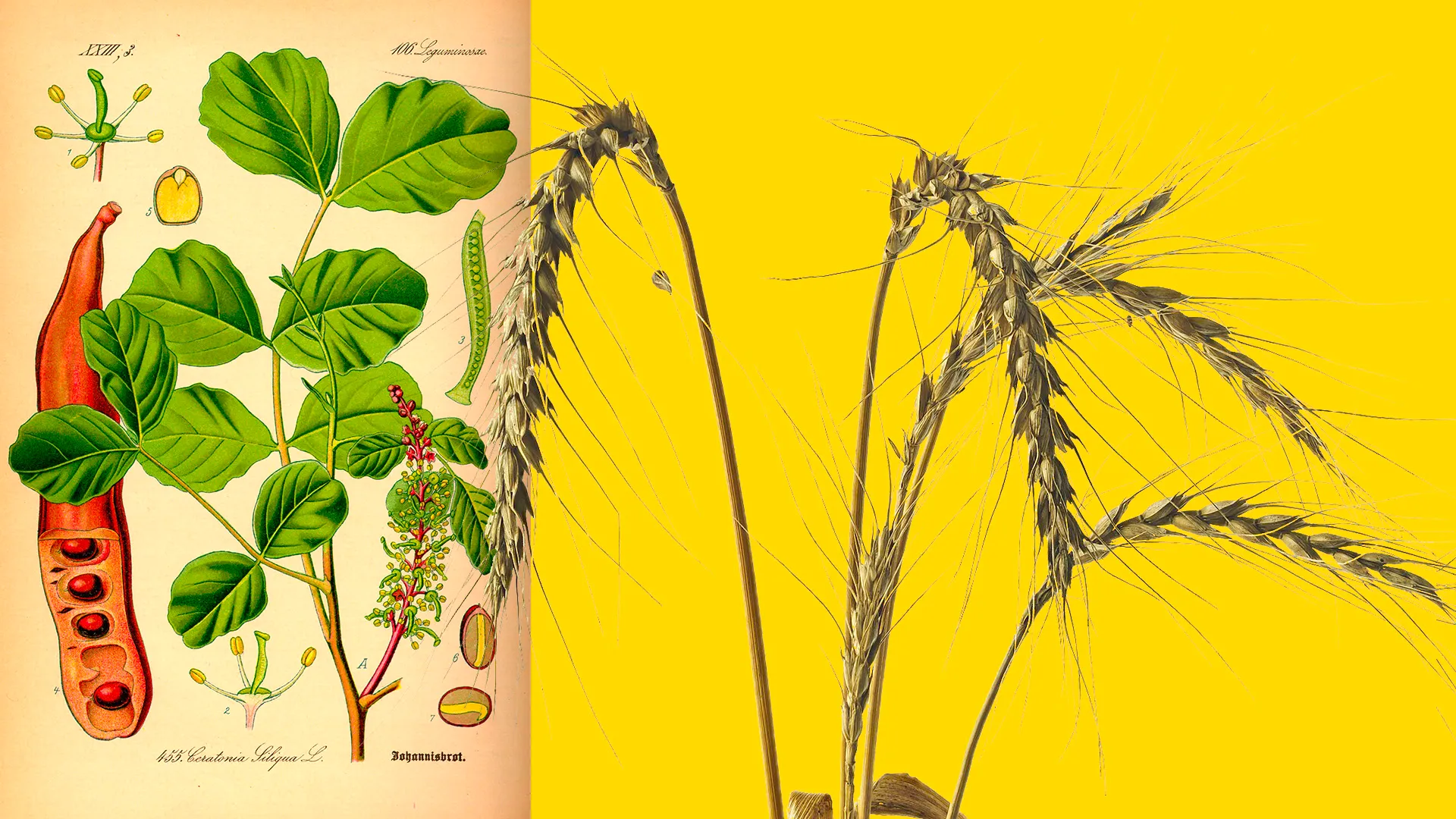
As with everything in cocoa and chocolate, the answer is, “It depends.” The featured image shows two of the ingredients used – carob and barley.
I wrote my first article about cocoa-free “alt.chocolates” for International Confectionery Magazine [Diclosure: I am their Technical Editor] well over a year ago. My coverage on the topic there and here has included PlanetA Foods (formerly QOA; Germany), California Cultured (USA), and WNWN Food Labs (UK).
WNWN showed up recently in my LinkedIn feed with a post about a new marketing campaign, one that I saw reported in Confectionery Production magazine (link below).

I was immediately reminded of a post I wrote back in 2021 that appears to be a similar marketing effort by Tony’s Chocolonely; the release of a set of “mock-off” bars, bars made to look like ones from Big Chocolate companies Tony’s is trying to call to account for their inability/unwillingness to address systemic labor issues in their cocoa supply chains.
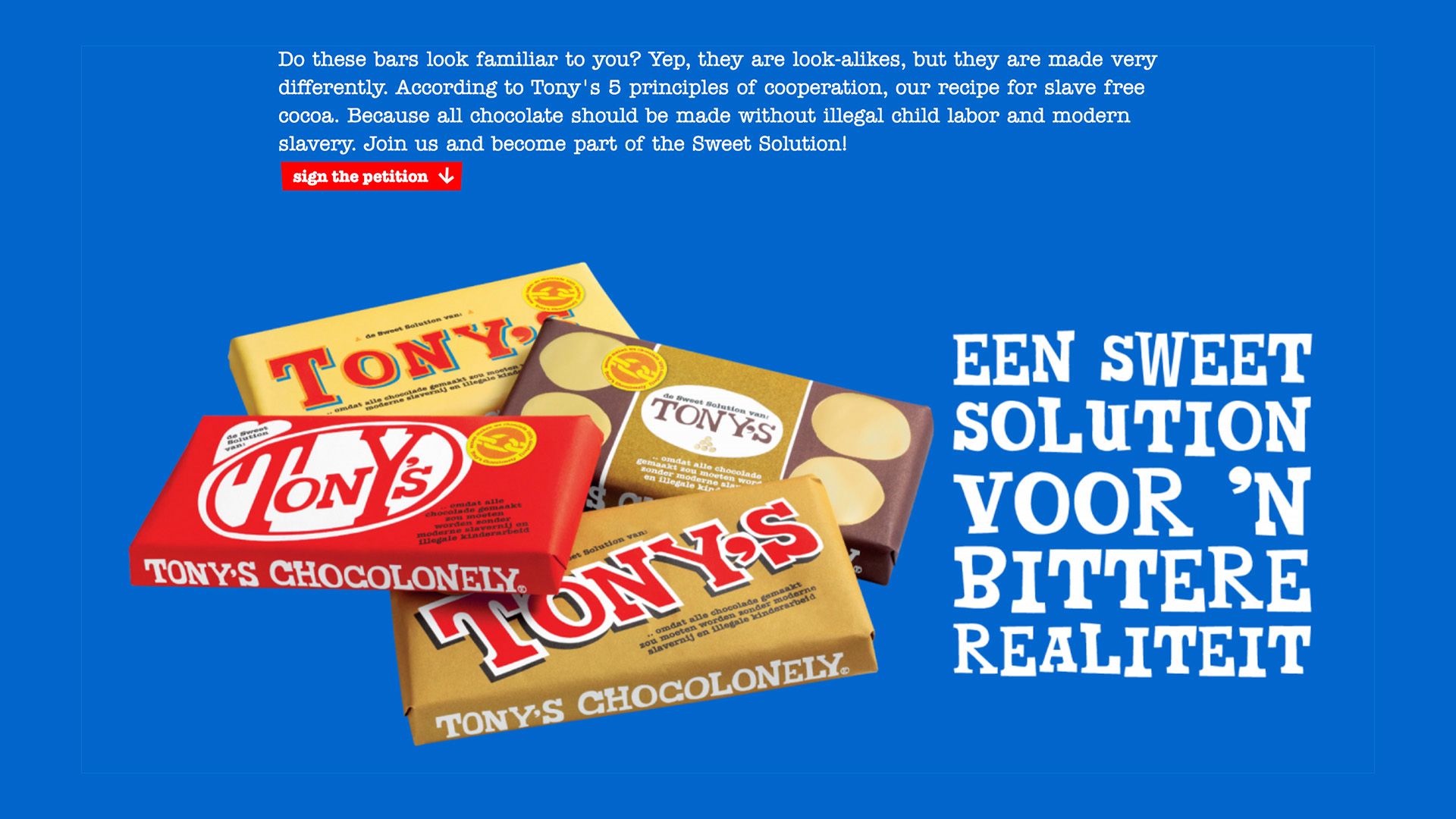
Published in 2021.
In this case, what WNWN looks to have done is to release three bars designed to a) showcase the company’s cocoa-free “chocolate” (aka “choc”), and b) contrast their product against what I presume they consider to be some of their competitors. One of those is Tony’s Chocolonely – which makes this pretty meta-Inceptiony.
Intrigued, I reached out to WNWN’s Commercial Director Jamie Bott for samples to see, read, and taste these bars for myself.
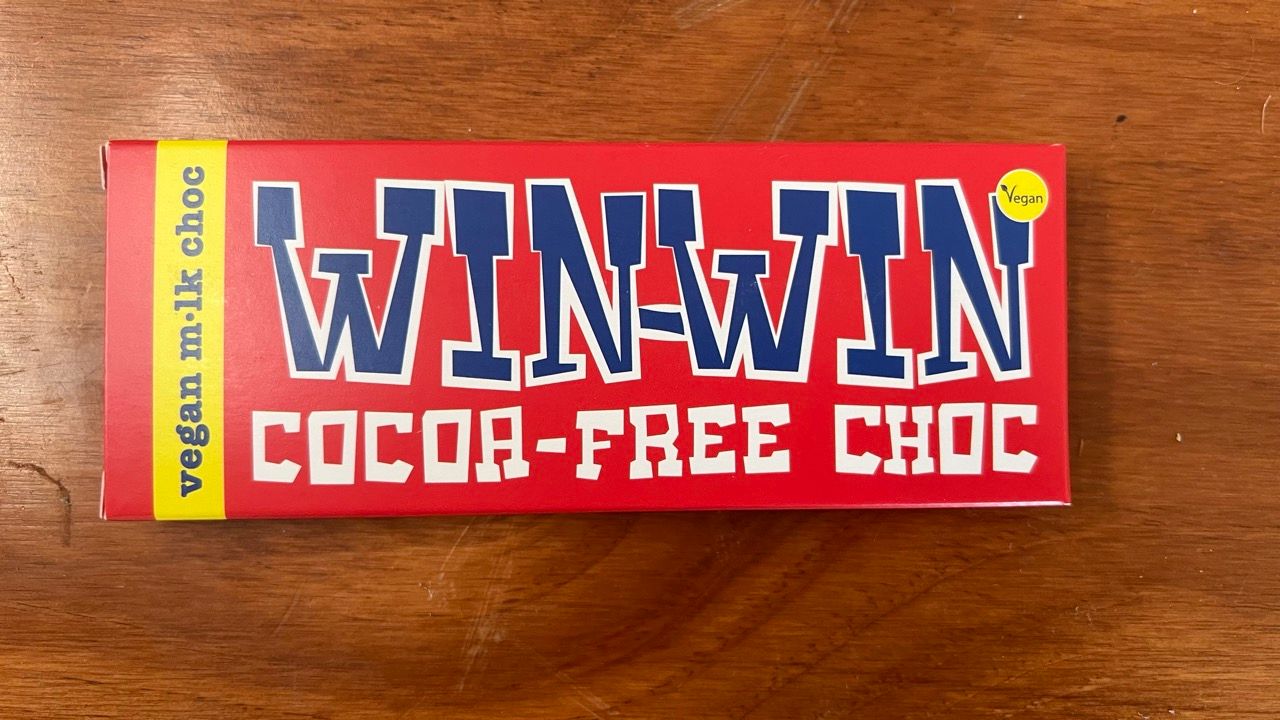
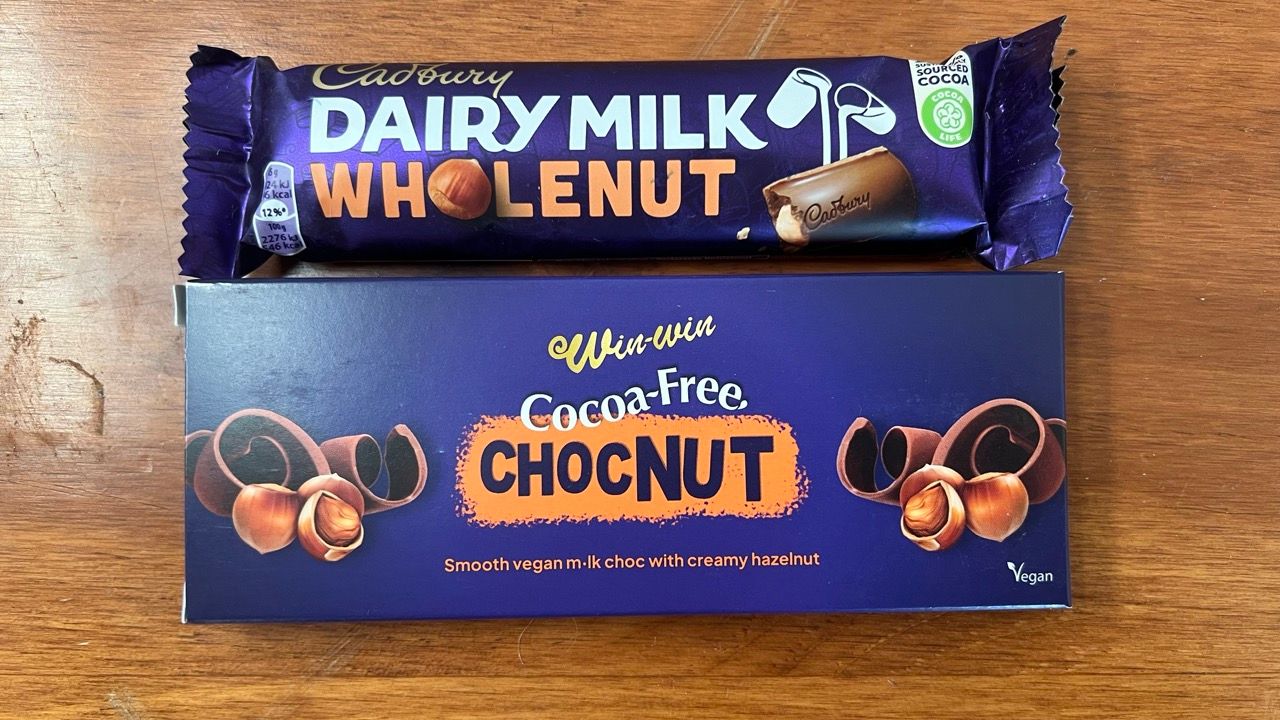
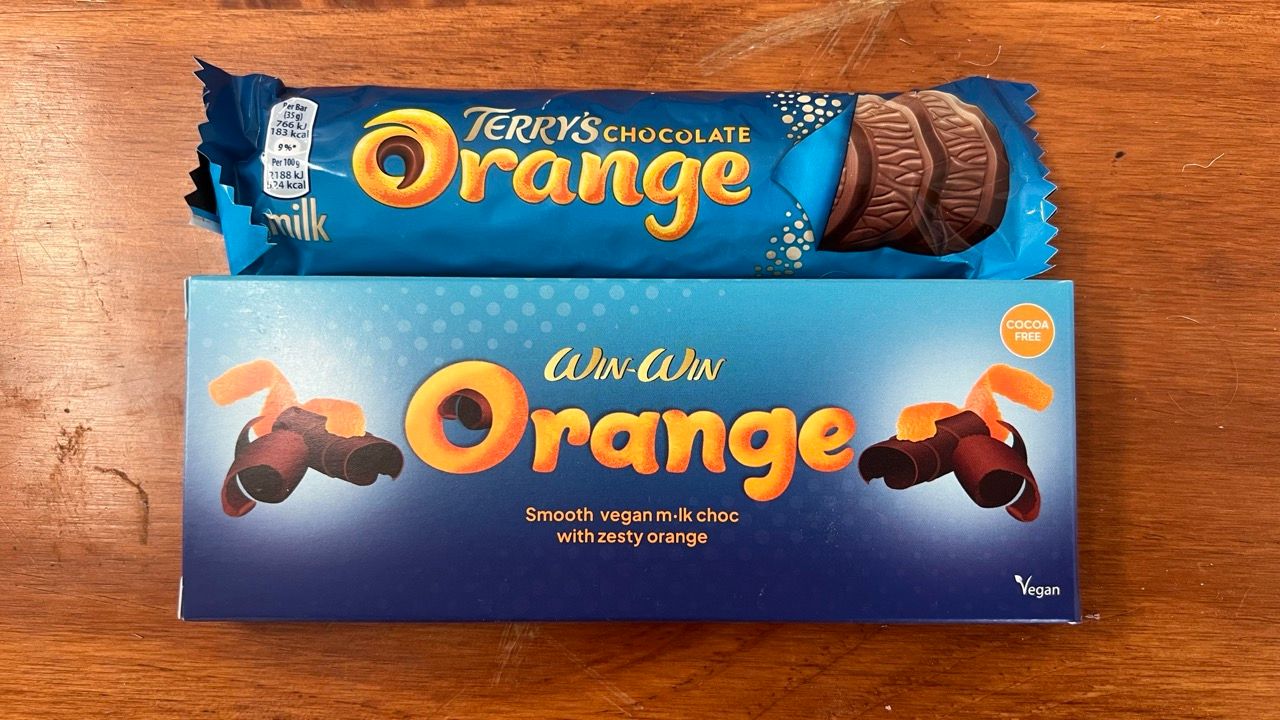
The samples I was sent – three WNWN bars and two inspirations. These are what I tasted for this review.
Collateral Material – Major Points to Ponder
Included in the package was a piece of print collateral. Citing a line from one piece (right photo below): “It tastes, melts, snaps and behaves like regular chocolate and its [sic] 100% vegan,” I did a full sensory evaluation and I did not pull any punches because WNWN claims “It tastes [...] like regular chocolate.”
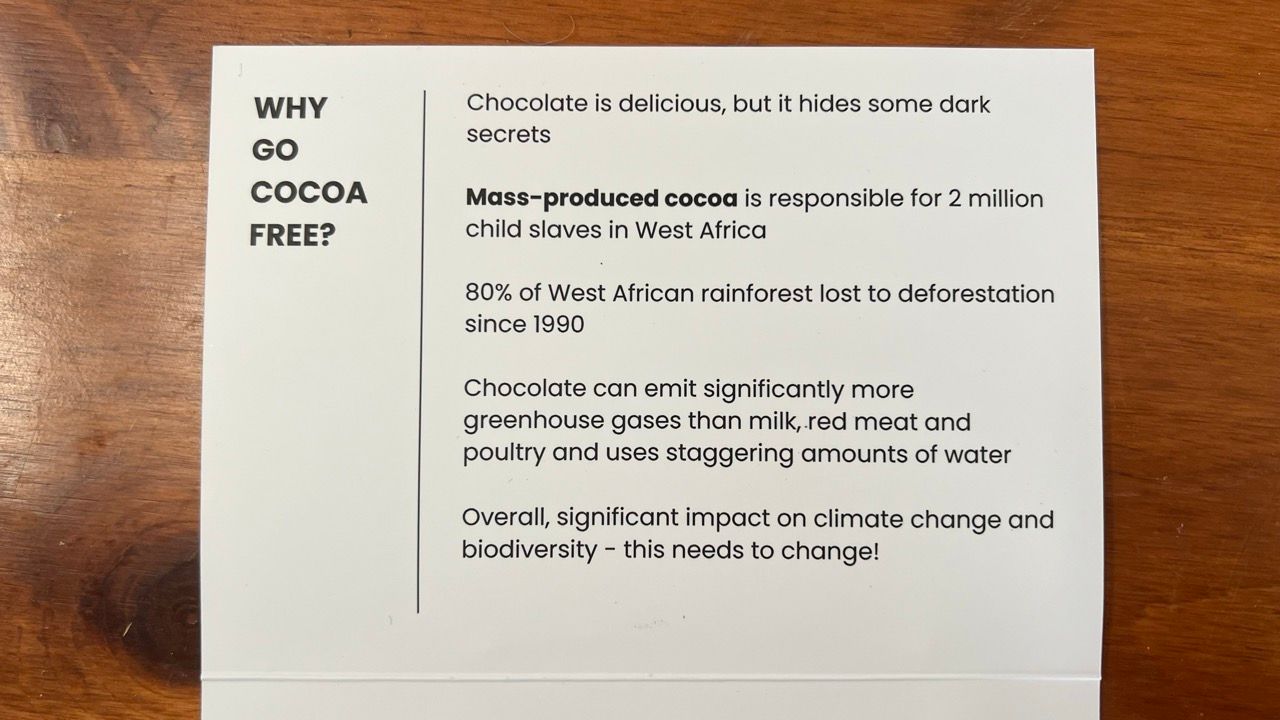
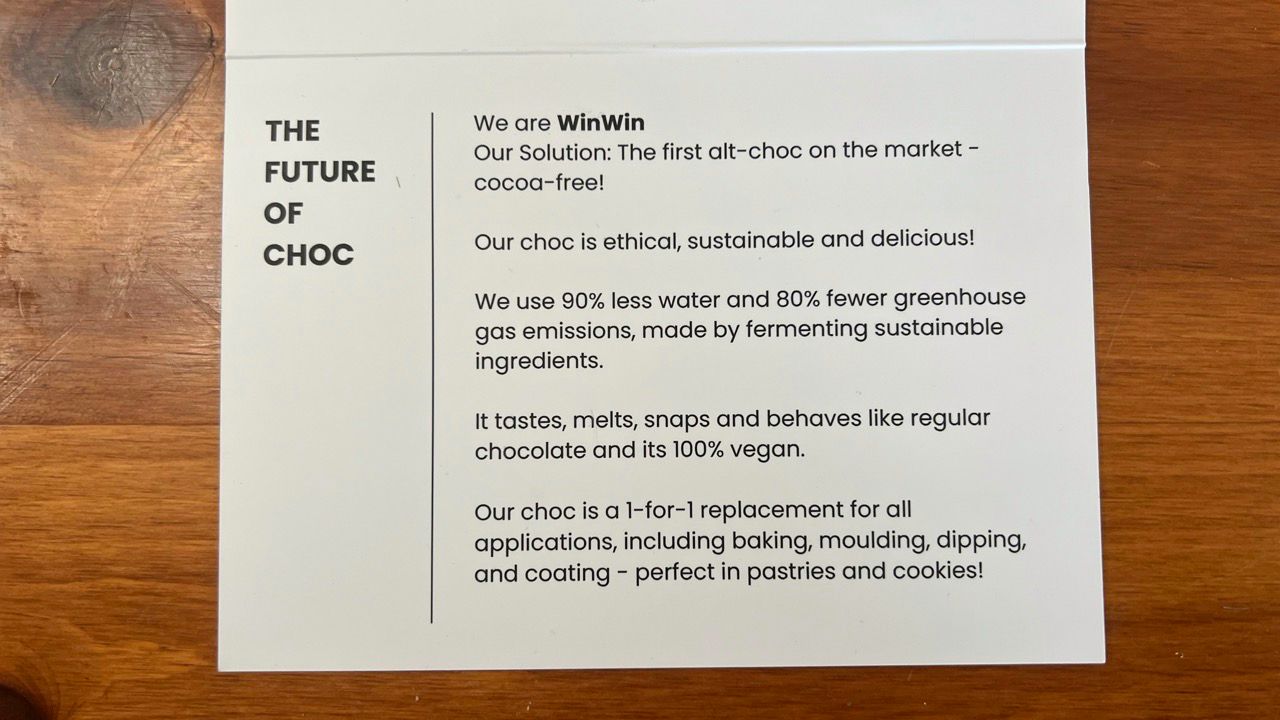
One piece of material WNWN included in the package they sent.
Right off the bat, the text of this piece of marketing collateral [left photo] exaggerates the current situation of illegal labor on cocoa farms in W Africa and – needlessly – undermines the position it is trying to stake out. The consensus of reports that cross my desk suggests there are roughly 1.3 million children involved in some form of illegal labor in Ghana and the Ivory Coast, with estimates of the number of child slaves at around 30,000.
If WNWN has credible sources to support the claims of 2 million child slaves they can send those to me and I will review them. I will unhappily update this criticism if I am wrong about the numbers.
So, at best, this is an example of poor fact-checking. At worst, it’s never a good idea to give a knowledgeable member of the press an easy point they can use to push back against your entire narrative ... in the second sentence of the materials you provide.
I also wonder about the equivocation in the word “can” when it comes to the comparison with milk, red meat, and poultry, given the unequivocal citation of child slavery numbers. This could just be one difference between UK and US grammar. However, the next sentence does not read to me as a complete one, so I don’t have a lot of confidence giving the author the benefit of the doubt here.
Another example is that WNWN does not “use” fewer greenhouse gas emissions [right photo] I am presuming they mean they produce fewer emissions. So I think it’s more likely a case of sloppy writing and insufficient editing oversight, which reduces not only my overall confidence in the claims being made but also my willingness to attribute them to just carelessness.
Ingredients
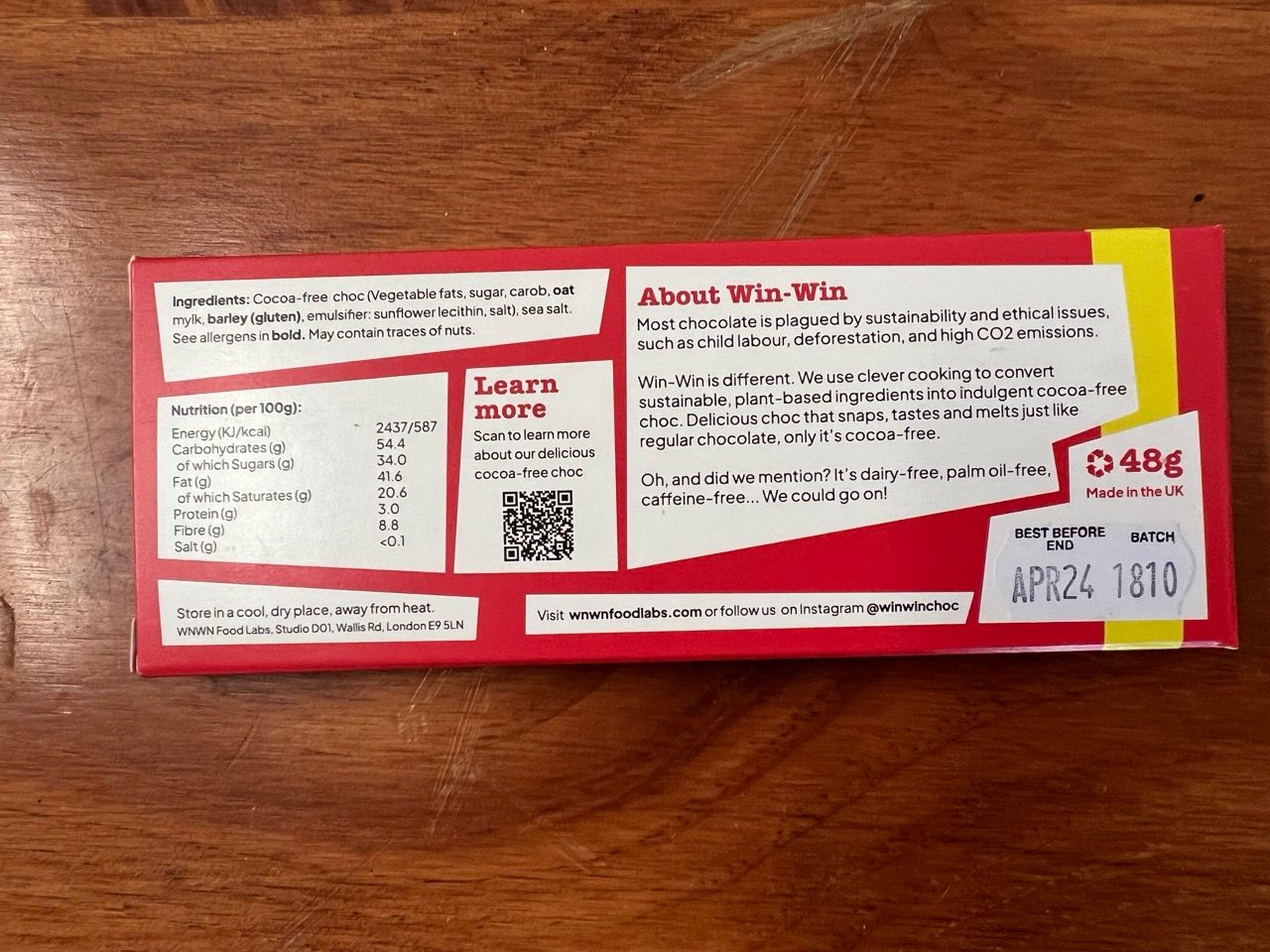
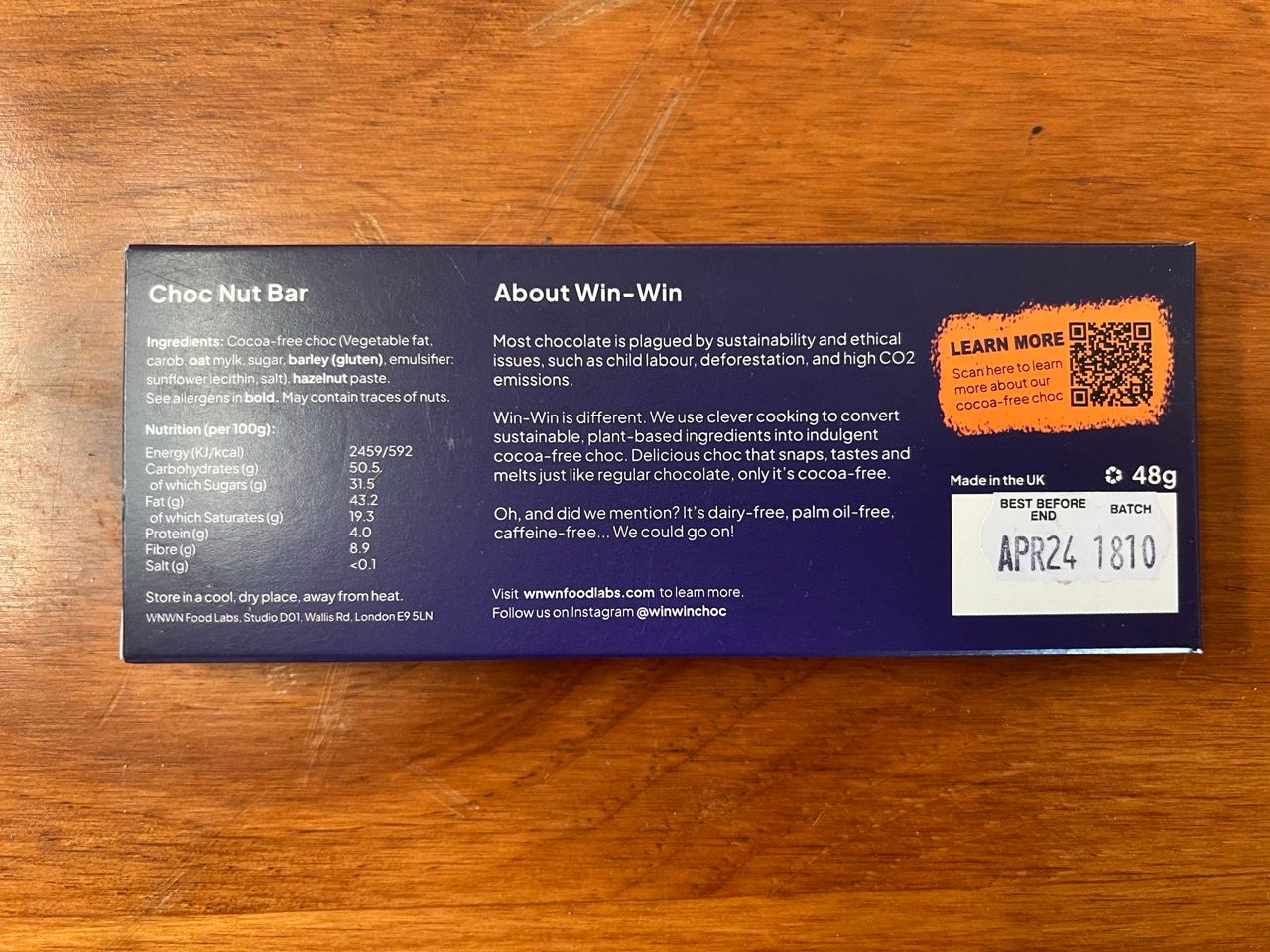
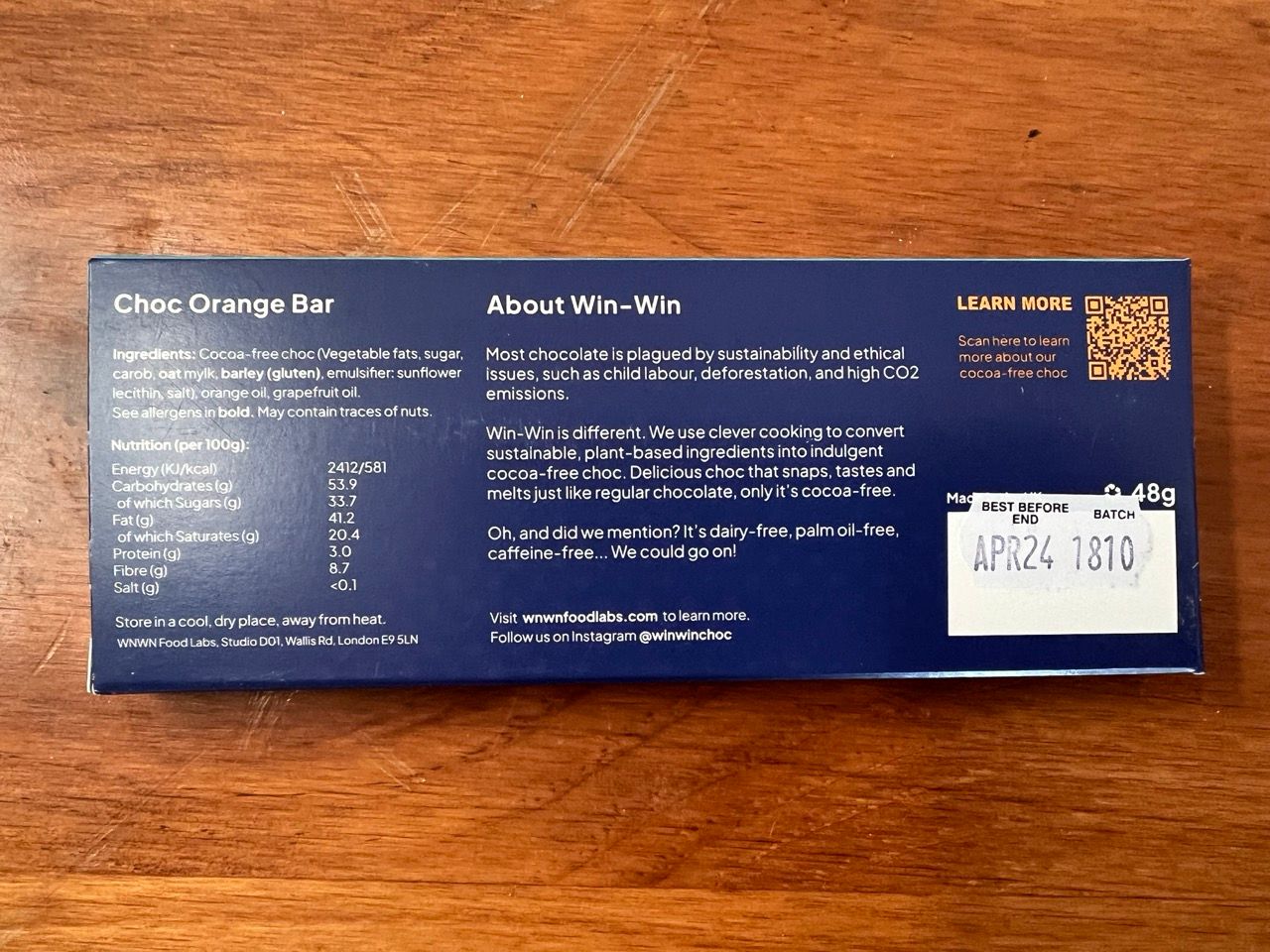
[Left]: Tony’s Milk mock-off. [C] Cadbury milk/hazelnut mock-off. [R] Terry’s milk/orange mock-off.
Tony’s Milk mock-off ingredients: Cocoa-free choc (Vegetable fats, sugar, carob, oat mylk, barley (gluten), emulsifier; sunflower lecithin, salt), sea salt.
Note: Allergens are bolded.
Cadbury milk/hazelnut mock-off ingredients: Cocoa-free choc (Vegetable fat, sugar, carob, oat mylk, barley (gluten), emulsifier; sunflower lecithin, salt) hazelnut paste.
Terry’s milk/orange mock-off ingredients: Cocoa-free choc (Vegetable fats, sugar, carob, oat mylk, barley (gluten), emulsifier; sunflower lecithin, salt), orange oil, grapefruit oil.
My guess is that 1% or less of all consumers are going to care to delve into the ingredients in detail. But this is my review and, in my opinion, ingredients are what WNWN is basing its claims on, so I feel like I have to comment.
A couple of things stand out to me here. The first is, “Why two of the ingredient labels list vegetable fats and one of them only lists fat (singular).” Is this, in fact, a different recipe or is it just a typo? Also, as a nerd, while the collateral and ingredient lists state there is no use of palm oil, I wonder what fats are used. The Cadbury Wholenut bar lists the non-cocoa-butter fats being used (shea and palm) so I wonder why WNWN is not being as forthcoming here. This matters to some extent, because cocoa butter is considered to be a healthier fat (like olive oil) and the alternatives WNWN uses might not offer those benefits.
From memory, the bulk fermented ingredient is the barley (so no WNWN bar with this recipe is ever going to be a gluten-free option), and carob is, presumably, the flavoring as there is no other flavoring, not even vanilla, mentioned.
Most of the world’s carob supply comes from Portugal, and the total harvest is just a small fraction of cocoa beans, which does speak to peak scalability – is there enough carob in the world to replace a significant portion of the global demand for chocolate?
Unboxing and Tasting
Tony’s Milk mock-off
Inside the paper box, which is labeled as recyclable, is a flow-wrapped bar in a clear, home-compostable bio-plastic flow wrap. My bar arrived broken into three parts (the bars were shipped in a box), and not cleanly along the break lines. The mold is a plain 3x5 break-up bar, and both the front and back were scuffed.
The packaging and mold used for all three bars is the same.
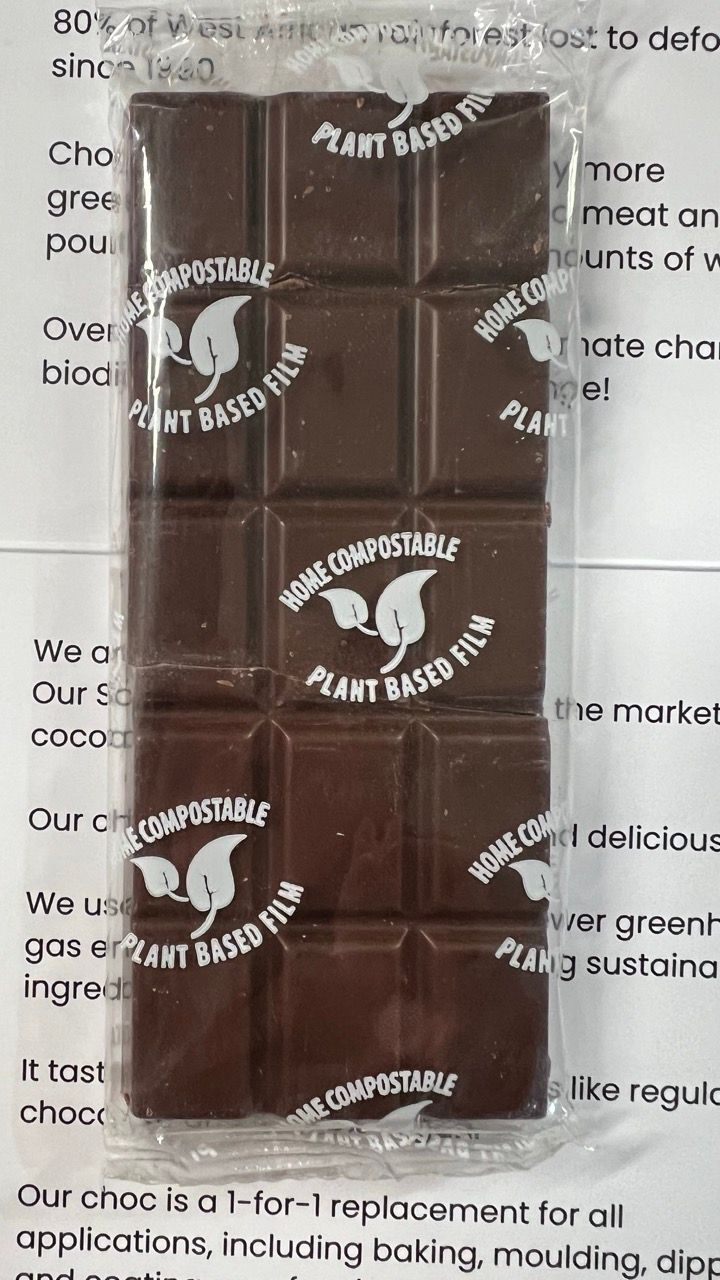
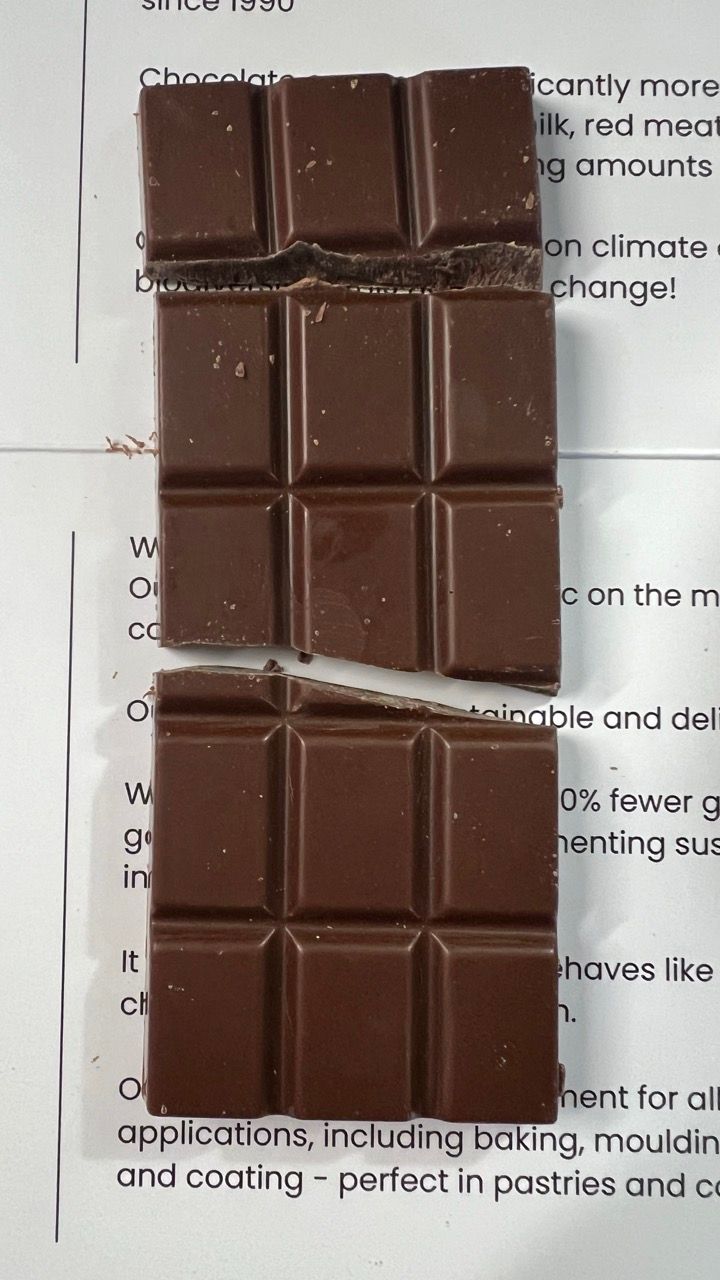
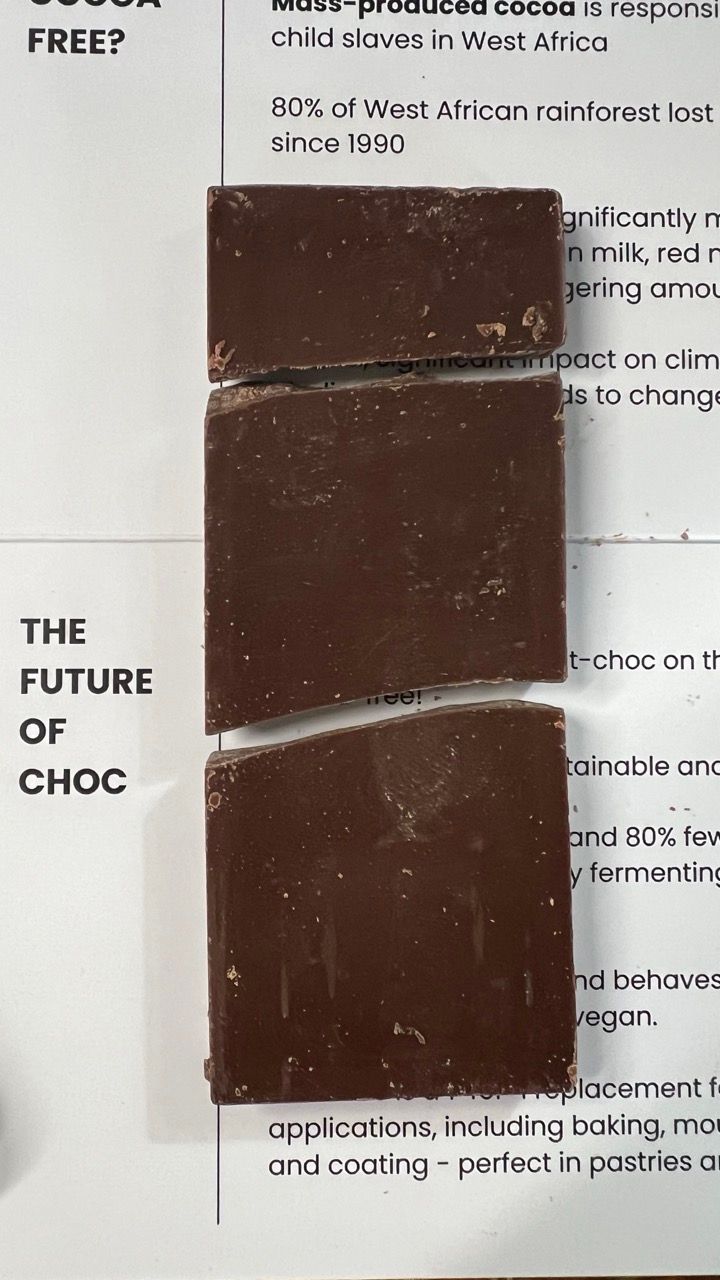
I have smelled actual milk chocolates that have less aroma than this bar does.
However what aroma there is is bready, not chocolatey, and it’s sweet, like a toasted Portuguese roll or Hawaiian bun. The snap is surprisingly crisp. The bite and chew are clean and the upfront melt is easy. The fat does not clear the mouth quite as easily and cleanly as cocoa butter might, and there is a slight sandy texture as the mouth clears. The primary taste, for me, is toasted bread with oat milk overtones, and that is what remains on the finish, which is surprisingly long. On the very end there is a very slight astringency under the tongue. It’s not unpleasant, but it is noticeable, in an “I am still here,” kind of way.
TL;DR review: I am not a fan of low/no-alcohol beers and wines. They resemble full-alcohol beers and wines but you know they’re missing something on the fulfilled satisfaction front. But you accept it because low/no alcohol/carbs/calories. This bar is like those beers and wines, or skim milk – lacking in some essential je ne sais quois of the full fat/carb/calorie normal version.
CHOCNUT (Cadbury Wholenut Milk/Hazelnut mock-off)
This snap on this bar was, again, surprisingly crisp, but then I went over to look at the thermostat and it showed it was 63F (17-18C) in the room. Assuming this is the same “m.lk choc” recipe as the previous bar (the fat/s in the ingredients was just a typo), the aroma on this bar has the same sweet toasted/bready taste with a hint of the hazelnut paste. The bite and chew are clean but there is a definite sandy texture that quickly clears. The hazelnut paste adds a faint complex sweet nuttiness to the taste that is not there on the plain bar.
This bar lacks the crunchiness of the whole hazelnuts in the Cadbury Dairy Milk Wholenut (CDMW) bar and is far less sweet, which is a good thing. The CDMW bar has unidentified “flavourings” in it and they impart a weirdly bright, unpleasant fruity/vegetal taste that persists. (Ick.) Overall, the bite, chew, and melt of the WNWN bar are noticeably superior to the “family milk chocolate” in the CDMW bar.
TL;DR review: On its own, the WNWN CHOCNUT bar is not a replacement for a good milk gianduiotti and it lacks the crunchy texture of whole nuts. I think the flavor is a little flat and it’s overall reminiscent of a lightly toasted Portuguese roll with, maybe, a skim (as in Marmite-thin) coat of hazelnut paste. In the end, the fat does not clear cleanly, as I would expect cocoa butter to normally do.
Orange (Terry’s Milk/Orange mock-off)
My bar arrived broken into three parts, and, again, not cleanly along the break lines.
There was virtually no aroma of orange when I stuck my nose close to the bar after opening the wrapper. There was a faint whiff after a few seconds but you’d miss it if you weren’t looking for it. As with the other two bars, the dominant scent impression I leave with is a lightly toasted Portuguese roll, even after I break off a square and smelled the fresh break. The bite, chew, and melt are the same as the other bars but the orange is initially suppressed. It ramps up after a few seconds, disappears quickly, but then reappears after a few seconds before beating in and out with the toast flavors on the finish. It is certainly the most complex of the three bars in that respect, though the orange flavor does not dominate.
The same cannot be said for the Terry’s bar. The orange and the chocolate are fighting to dominate the palate and not in a good way. There is an unhappy, unresolved, tension between the orange and the milk in the chocolate for the first thirty seconds or so. This tension is resolved in favor of the orange on the long finish. Terry’s ingredient list boasts the use of real orange oil, but one of my Food Rules (h/t Michael Pollan) is to avoid foods that self-label “Made with real ...” As in the CHOCNUT bar, the overall texture of the WNWN is softer and, to my taste, preferable than whatever chocolate Terry’s uses.
TL;DR review: If you’re going to make an orange-flavored bar, make it taste like orange. I think of classic British orange-flavored Jaffa cakes and I wonder why the flavourists on this bar took such a light hand. I don’t think it serves the bar, or the British orange/chocolate-eating public, well.
Conclusions
If that is, in fact, the case, then I don’t want to live in WNWN’s vision of the future.
Having prefaced my closing thoughts with the above, could WNWN’s cocoa-free “m.lk choc” alt.chocolate be a part of a future?
It sure could. But only time will tell.
It took many years for the “plant-based meat” market to take off, and after a relatively short time, consumer sentiment is reportedly softening as prices stay relatively very high and many products require consumers to compromise on their expectations for cultured or pea protein alt.steak vs. their memories of beef steak.
Similarly, WNWN’s cocoa-free chocolate, as it is currently formulated in these examples, has a long way to go before it becomes a convincing replacement for real chocolate.
But, there are many applications where WNWN’s products will make sense. For example in candy bars enrobed with compound or CBD-infused bars. I remember an interview I did with Johnny Drain about this last year (tasting what I think may have been a pre-production sample of the CHOCNUT product), during which I was told that the recipe was already less expensive to produce than real milk chocolate, even at relatively small-scale production. S0, alt.chocolates can find a place today in applications where the cost of ingredients, and other concerns, may be of greater importance than precisely replicating full-flavor chocolate.
The Final Word: While WNWN’s “choc” may “[...] melt, snap, and behave like regular chocolate, it does (yet) not taste like a real milk chocolate made with cocoa beans.
Whether someone likes these WNWN bars (or other products made with this m.lk choch) is a complex mashup of taste and other preferences. One has to consider how other attributes of the product – lower cost, reduced environmental impact, low-t0-no illegal child labor, etc. – factor into the purchase decision. But for many chocolates, especially mass-market confections that currently use compound, the switch will have little to no impact on the eating experience.
Reference Links

The company’s website.

To compete in the big leagues, you have to have the support of the majors. But at what cost?
Related TCL Posts
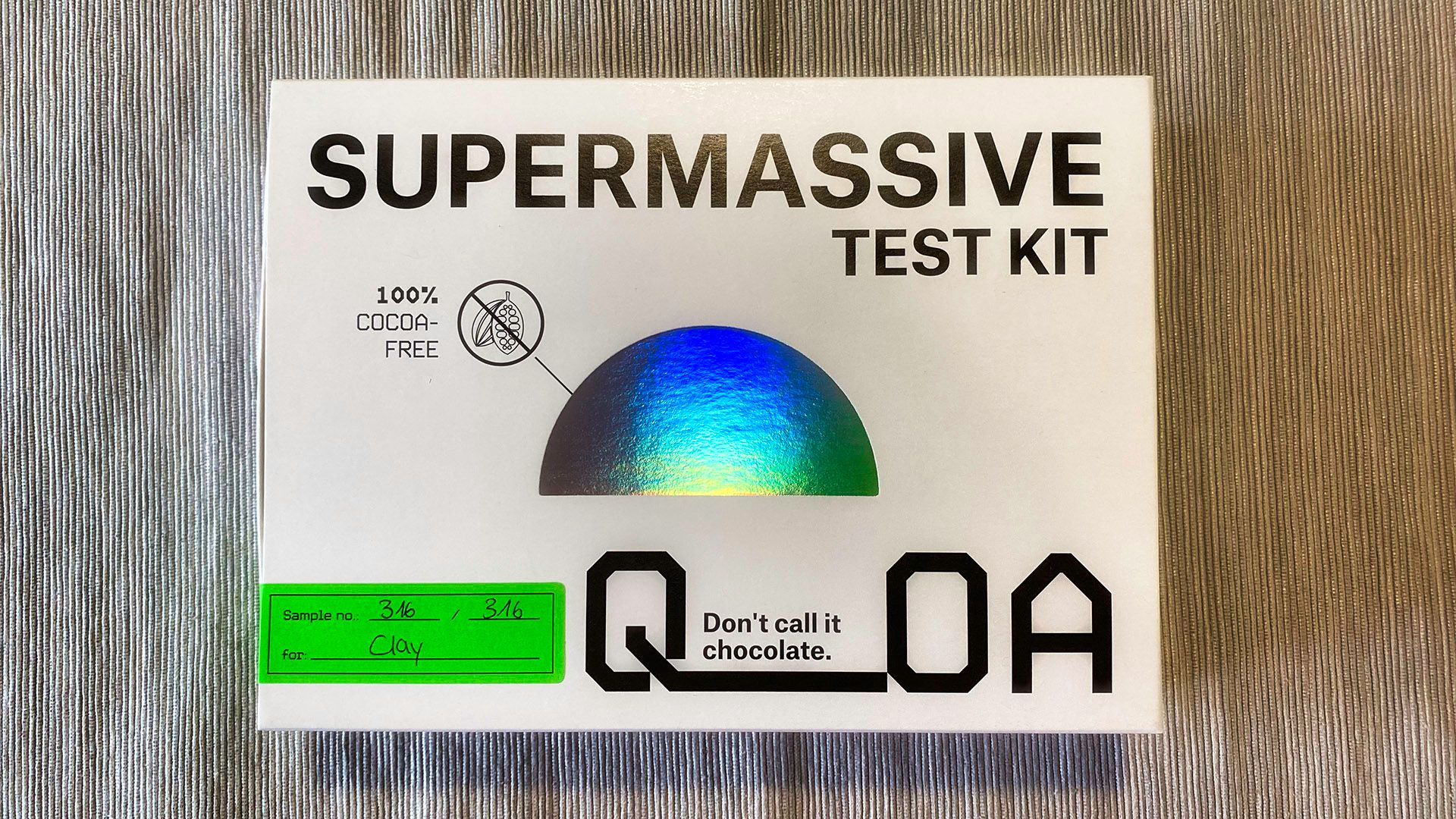
Publication date of update: September 14, 2022.

